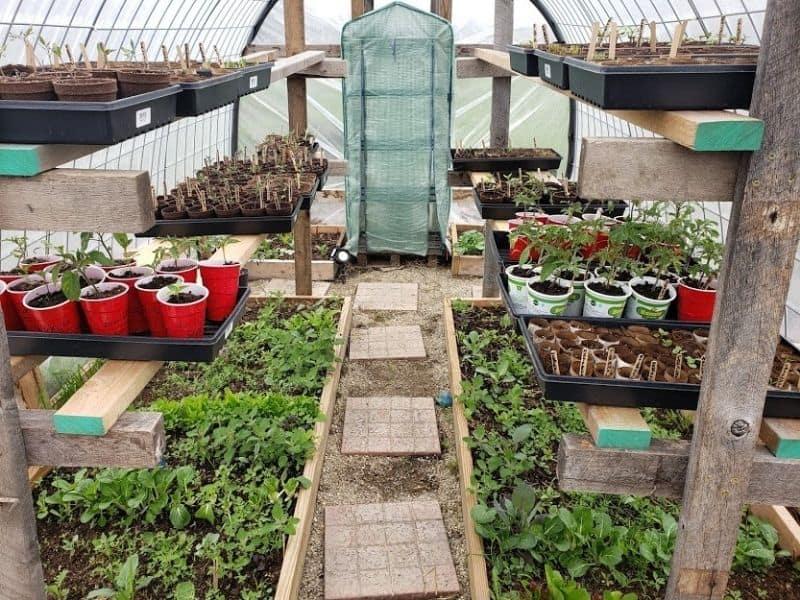One of the topics that come up often about getting into permaculture is the cost of getting started. Many people find it daunting because they believe that apart from permaculture taking a lot of time and patience, it also takes a lot of money. Plus, how can it be profitable when competing against modern agricultural farms?

The cost to start permaculture can include:
- Fencing costs.
- A chicken coop.
- The kinds of plants you want, depending on the produce you want to consume.
- Setting up the greenhouse.
Permaculture is profitable in many ways. One of them is selling the plants that are in the nursery.
Often we weigh decisions between choices based on what they cost us. However, do you consider that one of those choices may make you money in the long run versus investing in something that just costs more and more? Permaculture is an investment, an important asset. Stay tuned if you want to know the financial aspects of creating a food forest in your backyard.
How Much Does It Cost To Start Doing Permaculture?
This is a very common question that pops up often and with good reason. Modern agricultural farming costs a pretty penny to get it up and running. One has every right to wonder if permaculture farming costs just as much.
The good news is that permaculture farming can make you money. With that being said, it does cost you money to get started. Almost everything does. But how many of those things are worth it in the long run and pay for themselves ten times over?
Although you think it might be a good idea to minimize your upfront cost, that is not the case as you need to think long term. More important is that you focus on getting a good variety that will grow well in your area and produce long term.
Does It Cost A lot To Set Up A Fence?
The first expense that you might need to focus on is a fence. If you are starting permaculture in a place with a lot of wildlife, like deer, you may need to consider putting up a fence to prevent any damage from being done to your plants and to protect your chickens. This may cost you a pretty penny, depending on the acres of land.
If you prefer to DIY, you can set up your fence using wood from trees nearby and any other natural materials. That way there will be minimal costs.
You Might Need Chickens For Fertilizer.
Because you need fertilizer, you might need to consider getting chickens. A chicken coop is another cost that you will need to consider. Yes, you can get fertilizer from harvests that fail or from the kitchen, but animal fertilizer is rich in the nitrogen that soil thrives on.
Can Permaculture Be Done Without Animals? (Here’s The Answer)
The Cost Of The Plants That Need To Be Planted.
If your soil is not nutrient-rich enough, you will have to get topsoil and compost to get started. Depending on what kind of plants you want to go for, you will have to purchase seeds or older trees to produce fast. For example, good quality fruit trees are about $60 to $80 each. Exotic plants will cost more but will be beneficial in the long run.
The Cost Of Setting Up A Greenhouse.
A greenhouse is not a must when you first start, but it is ideal for saving seeds and starting your vegetable plants. Sometimes it may cost more to heat if the climate is cold, but you can sometimes get away with just insulating it.
There are many types of greenhouses or hoophouses to choose from but an inexpensive and simple to build option is a cattle panel hoophouse.

Finally, the system will constantly evolve, and it will be dependent on your yard and what you want to eat, as well as what you want to grow. Observe and have fun!
Is Permaculture Profitable?
Yes, permaculture can be profitable. There are many ways to make a livelihood from permaculture farming with very little maintenance. The last thing you want to happen is to save up to get started with permaculture without being certain about sustainability and profitability.
There are many different viable permaculture models and designs that make different scales of farms very profitable. So, now that we know that it is possible to make a profit with permaculture, the question is, where does that profit come from?
Many operations bring in an income stream. Here are some of the few that you can look into incorporating once you are up and running:
How Can You Make Money From Nurseries?
It is possible to make a living from perennial food and medicinal-bearing plants. There is a very high demand for perennial foods and exotic plants because people know that those plants come from nurseries that do not use any chemicals and take care of the soil.
You must keep in mind that it will take time to make sizable returns with perennial plants, but they are very profitable once they start reproducing. You’ll have a surplus of plants that many people will be interested in having in their backyards. Building a client base and putting your nursery out there is important to get customers.
How To Make Profit By Selling Produce.
The sale of produce and products can lead to a lot of profit, especially if you make sure to diversify for the various seasons. You can sell flowers, organic vegetables and fruits, herbs, beans, free-range eggs, meat birds, etc.
You could also turn your produce into self-fermented wine, fruit juice, ciders, olive oil, etc., and sell those too. You can sell the produce to local vegetable markets or enterprises that use fruit to make fruit juices, etc.
Can You Make A Profit By Providing Consultancy Services?
Now that you have successfully started and run a permaculture farm, many people will approach you for help, or you can market your services. This is another excellent way to make money by helping others with permaculture on their properties. There is a lot of money that can be made from designing and constructing permaculture landscapes.
Set Up Educational Workshops And Tours To Generate Income.
Another great way to make a profit is to have workshops and tours. The tours can be a way you charge people to show them how successful you have been with your permaculture and how the ecosystem works well.
The workshops will demonstrate and teach people how to set up something like a rainwater harvesting system or how to have zero waste. Suppose you are not a fan of having people physically come over. In that case, you can have presentations or speaking events at different locations or even sell video DVDs showing a walkthrough of your permaculture farm/garden.
Permaculture Lowers Expenses.
Although the main focus is on expenses, these can be technically classified as income, as lowered expenses mean more income or less spending. The more you become self-sufficient and self-reliant, the less fuel you use, the less you focus on store-bought produce, and the more you save.
Conclusion
Starting permaculture is cheaper than modern agricultural farming as permaculture is usually done on a small piece of land and does not require tractors, etc. Permaculture is not only sustainable but can be profitable in many ways.




Doesn’t require tractors..lol
We had ten acres of abandoned land..had to use one..
@Kathy, It would certainly depend on the size of your land and what you need to do to make it productive. A tractor could make the job easier and even more cost-effective in some cases. However, most people I’ve consulted or talked with about the conversion of their property to a permaculture homestead/farm are dealing with much less land. In many cases less than 3 acres which ends up being designed as a food forest and not requiring a tractor.